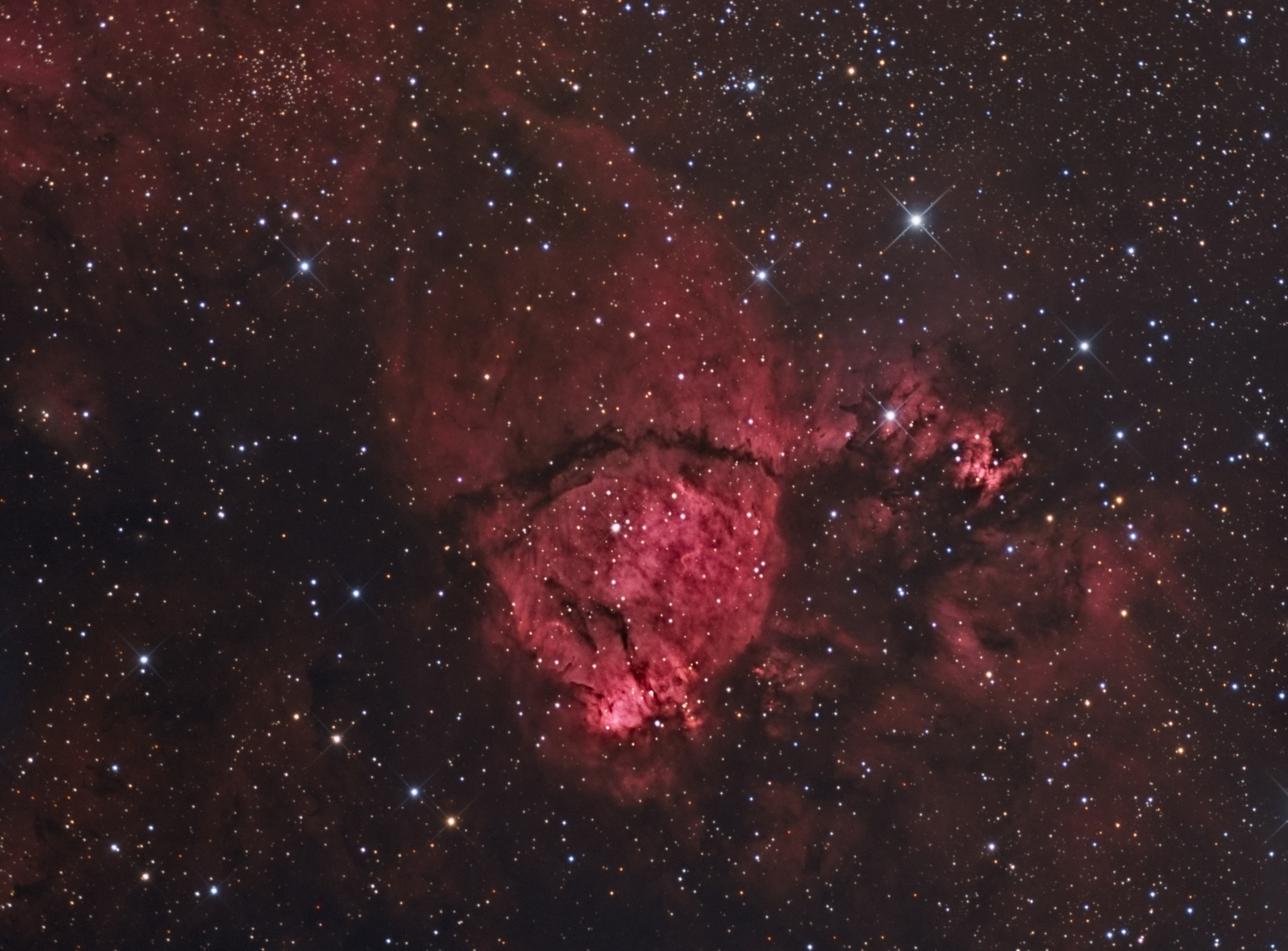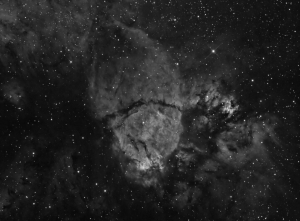IC1795, Fish Head Nebula
 Click image for full size version
Click image for full size version
October 21, 2015
IC1795 is an emission nebula composed mainly of glowing hydrogen gas. It lies about 6,000 light years away in the direction of Cassiopeia. It is an extension of the famous Heart Nebula (IC1805) and lies close to the Soul Nebula (IC1848). I’ve seen it referred to as the Fish Head Nebula and the North Bear Nebula. I can visualize the former, but not the latter. Maybe I’m just not looking at it the right way…
 The colour image above blends the red, green and blue channels with data collected through a deep red H-alpha filter that lets in just the light emitted by hydrogen atoms. The black and white image at right shows the H-alpha data alone; click on the image to see it full size. The eye is better at picking out detail in black and white images than colour images. The stars are smaller in the Ha version because most starlight is emitted at wavelengths other than H-alpha. The colour and mono versions complement each other, and I hope you enjoy them both.
The colour image above blends the red, green and blue channels with data collected through a deep red H-alpha filter that lets in just the light emitted by hydrogen atoms. The black and white image at right shows the H-alpha data alone; click on the image to see it full size. The eye is better at picking out detail in black and white images than colour images. The stars are smaller in the Ha version because most starlight is emitted at wavelengths other than H-alpha. The colour and mono versions complement each other, and I hope you enjoy them both.
Tekkies:
SBIG STL-11000M camera, Baader Ha, R, G and B filters, 10″ f/6.8 ASA astrograph, Paramount MX. Guided with QHY5 camera and 80 mm f/6 Stellar-Vue refractor. Acquisition and guiding with TheSkyX. Focusing with FocusMax. Automation with CCDCommander. Calibration, cosmetic correction, registration, integration and all processing in PixInsight. Shot from my SkyShed in Guelph, Ontario. Moderate moonlight for Ha and no moon for RGB. Good to very good transparency and seeing throughout acquisition.
13x30m Ha, 10x15m R, 10x15mG and 10x15mB unbinned frames (total=14hr).
HaRGB
Creation and cleanup: R, G, B and Ha masters were cropped and processed separately with DBE. The R,G and B channels were combined and the resulting RGB image was processed with ColorCalibration. The NBRGBCombine Script was applied to Ha and RGB with default settings to produce a linear HaRGB image. PixelMath was used to boost the blue by adding 5% Ha.
Linear Noise Reduction: MultiscaleLinearTransform was used to reduce noise in the background areas of the HaRGB image. Layer settings for threshold and strength: Layer 1: 3.0, 0.5 Layer 2: 2.0, 0.39 Layer 3: 1.0, 0.25 Layer 4: 0.5, 0.1
Stretching: HistogramTransformation was applied to make a pleasing yet bright HaRGB image. TGV Noise was applied and the image was re-stretched to reset the black point.
Synthetic Luminance and H-alpha only
Creation and cleanup: The cleaned up Ha, R,G and B masters were combined using the ImageIntegration tool (average, additive with scaling, noise evaluation, iterative K-sigma / biweight midvariance, no pixel rejection). The Ha master was copied, with the copy used for the Ha-only image.
The following steps were done in parallel on both the SynthL and Ha-only masters.
Deconvolution: A copy of the image was stretched to use as a deconvolution mask. A star mask was made from unstretched SynthL to use as a local deringing support. Deconvolution was applied (100 iterations, regularized Richardson-Lucy, external PSF made using DynamicPSF tool with about 20 stars; local deringing at 70% and global dark deringing at 0.08.
Linear Noise Reduction: MultiscaleLinearTransform was applied to reduce the noise. Layer settings for threshold and strength: Layer 1: 3.0, 0.5 Layer 2: 2.0, 0.39 Layer 3: 1.0, 0.2 Layer 4: 0.5, 0.1
Stretching: HistogramTransformation was applied to make an image with similar brightness to the HaRGB image. To achieve this the luminance channel of the HaRGB was extracted and used for visual comparison. TGV Noise was applied using a mask to protect high-signal areas and the image was re-stretched to reset the black point.
Combining SynthL with HaRGB:
The luminance channel of the HaRGB image was extracted, processed and then added back into the HaRGB image as follows:
1. Extract luminance from the HaRGB image.
2. Apply LinearFit using SynthL as the reference.
3. Use ChannelCombination in Lab mode to replace the HaRGB’s luminance with the fitted luminance from step 2.
4. LRGBCombine was then used to make a SynthLHaRGB image.
Final Processing
SynthLHaRGB: HDRMultiscaleTransform was applied at 6 and 4 pixel scales using a mask to protect stars and dark areas. LHE was applied at scales of 50 and 150 using the same star mask (strength 0.25 for both). A light unsharp mask was applied to the stars and bright areas of the nebula. Overall contrast and brightness were increased slightly with the Curves tool. A slight blue cast was removed with an adjustment of the Red channel in Curves. The DarkStructureEnhance script was applied with default settings except that strength was reduced to 0.25.
Ha only: The highlights were sharpened slightly with unsharp mask. Overall contrast and brightness were increased slightly with the Curves tool.
Image scale is about 1.1 arcsec per pixel for this camera / telescope combination.






Leave A Comment